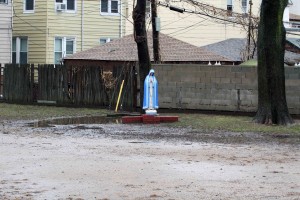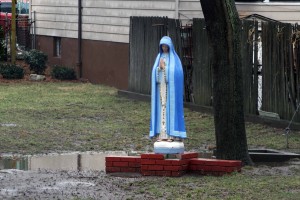OUR MOTHER OF THE MUD
Jodie Childers
PDF of this Piece // PDF of Issue 3
Previous Piece
Artist Statement
Divinity is what we need to become free, autonomous, sovereign. No human subjectivity, no human society has ever been established without the help of the divine.
– Luce Irigaray, “Divine Women,” Sexes and Genealogies.
Does female divinity represent a force of repression and control or a source of inspiration and liberation? This work explores a photographer’s ambivalent response to an unexpected encounter with simulacra of Mary, finding in the icon a paradoxical tension between degraded and sacred female bodies and a surprising metaphor for affective resistance.
The photographer is first attracted to Mary as other, seeing only difference between the feminist artist and the disembodied statue. Unlike Mary, the photographer is a childless dissenter, an atheist and an outcast, but she cannot help but admire the icon’s kitschy, anachronistic beauty and the ironic tension between her spiritual signification and her physical degradation. Reflecting on the subservience of the statue to God and nature, she begins to reimagine Mary as an altruistic submissive, an unprotected protector who opened her womb for the world, actively forsaking her own autonomy in an act of humility and vulnerability—now condemned by choice to pray over the mud, interceding for humanity in a futile but infinitely hopeful gesture, enduring both the weather and the neglect of all who pass by on the street. By transforming Mary from virginal victim to consciously compliant, the photographer reframes not only the statue but her own perception of reproduction and prayer, recasting Mary’s submission and supplication as affective labour. This framework challenges the photographer’s limited vision of feminism and complicates her understanding of what it means to resist patriarchy through the body, heart, and soul. Building an uneasy alliance with Mary allows the photographer to reassemble the incongruous pieces of her own fractured self into an imperfect whole.
The three shots, like the poem, tell a narrative that begins outward and moves inward toward a more profound understanding of Mary as a symbol for a type of sacrifice that the photographer respects yet resists from beginning to end. The first shot is taken through the gate emphasizing feelings of detachment and alienation from Mary and the church. The second photograph places the icon within the larger context of the dilapidated churchyard. Here the photographer begins to imagine the wildness in Mary and the possibility for affective rebellion through sacrifice, submission, and patient endurance. Zooming in to capture a more intimate, perspective of Mary, the final photograph highlights the color and detail in the physical form, conveying simultaneously the photographer’s discomfort with the weighted, sacrosanct tradition of the biblical Mary and her own complicated re-rendering of this particular Mary through her own sensate aesthetic experience of the statue in the rain.
This encounter, a moment of startling communion, causes the photographer to question her own simplistic understanding of what it means to be a feminist artist. Perhaps it is through a seemingly contradictory blend of materialism and mysticism that the artist can begin to understand what it means to create in and through the body, the mud of the earth infused with the mystery of life.
The Photographer’s Magnificat
Mary, mother of the mud,
I hail you in this frame,
though I would have resisted
even had Gabriel ask nicely—
Not to be done
according to his word,
not to be done at all,
no savior to be born,
all to return to dust,
a lineage, forever lost—
But you have let yourself
be sculpted into supplication,
infinitely interceding
in divine subversion.
And for that,
blessed art thou
amongst women in the rain—
But I would have said, No.
Works Cited
Irigaray, Luce. “Divine Women.” Sexes and Genealogies. Trans. Gillian C. Gill. New York: Columbia University Press, 1993. 55-72. Print.
Jodie Childers is a New York-based writer and documentary filmmaker who is primarily interested in the intersections between the arts and social action. She wrote and produced The Other Parade, which aired on RTE in Ireland and follows Brendan Fay, an LGBT activist who founded the All-Inclusive St. Patrick’s Day Parade, and she is currently working on a multimedia exhibition for the UN Women’s Caucus for Art and a feature length documentary film about Pete Seeger’s environmental legacy. Her video work has been used by nonprofits, educational institutions, and has been included in In These Times. Her writing has been published in many literary journals including Eleven Eleven, Poetry East, and The Portland Review, and has received numerous awards including two Pushcart Nominations and a Dorothy Sargent Rosenberg Prize. She received an MA in literature from Duquesne University, an MS in library science from the University of Pittsburgh, and an MFA in creative writing from Brooklyn College. She is currently an assistant professor of English at Queensborough Community College-CUNY.



